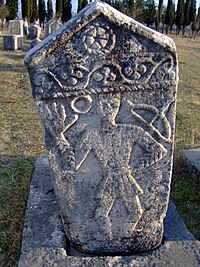Tag:historic=stećak
| Description |
|---|
| Specifies megalithic gravestone from medieval Bosnia. |
| Group: historic |
| Used on these elements |
| Status: in use |
| Tools for this tag |
|
A stećak=* is a monumental gravestone slab or megalith, cut exclusively in Dinaric Karst limestone in variety of sizes and shapes which, however, followed ordered pattern, erected as a monument (tombstone) on top of the grave and mostly grouped in cemeteries or necropolises, but sometimes as tombstones for individual graves. At present there are more than 60 thousand individual ![]() stećak tombstones in
stećak tombstones in ![]() Bosnia and Herzegovina, and another several thousands in border areas of neighboring countries, mostly in necropolises comprised of few to few hundreds of individual stones. A stećak has been used as early as beginning of the 12th century to as late as mid to late 16th, in some cases early 17th century, for funerals or commemorative purposes.[1][2]
Bosnia and Herzegovina, and another several thousands in border areas of neighboring countries, mostly in necropolises comprised of few to few hundreds of individual stones. A stećak has been used as early as beginning of the 12th century to as late as mid to late 16th, in some cases early 17th century, for funerals or commemorative purposes.[1][2]
Stećaks that will later evolve into transitional variety of stećak-"nišan"s, a variety of stećak used in late medieval Bosnia by first converts to Islam after the Ottoman conquest of the Kingdom of Bosnia, could be mapped as stećak in combination with religious affiliation. Later still, these stećak-nišans will evolve into their final form as Muslim gravestones called nišan(s).[3]
On initiative of the Commission to Preserve National Monuments of Bosnia and Herzegovina, stećaks are inscribed on the World Heritage List on Wikipedia by UNESCO on Wikipedia since 2016. More than 4,000 individual monoliths are selected, and grouped in necropolises at 28 locations, of which 22 in Bosnia and Herzegovina,[4] two in Croatia, three in Montenegro, and three in Serbia.
How to map
The stećak=* key is used to tag features that still exist or of which traces are observable, and that are of historic interest, or where the feature class is generally of historical interest (e.g. individual stećak are tagged like this, while replicas should be tagged as man_made=monument with stećak=yes).
Many historic sites are important tourist destinations.
For individual stećak, add a node ![]() and add historic=stećak + name=* + inscription=* + heritage=* + ref:kons=* + kons:decision_number=* + kons:inscription_date=*. If a significant individual stećak(s) is encountered, draw those as an area. This can be done also inside necropolis area
and add historic=stećak + name=* + inscription=* + heritage=* + ref:kons=* + kons:decision_number=* + kons:inscription_date=*. If a significant individual stećak(s) is encountered, draw those as an area. This can be done also inside necropolis area ![]() . Use combination with stećak=stećak_necropolis + stećak:stećak_count=* + inscription=* + stećak:relocated=* + material=limestone + name=*.
. Use combination with stećak=stećak_necropolis + stećak:stećak_count=* + inscription=* + stećak:relocated=* + material=limestone + name=*.
Tags to use in combination
- name=*
- heritage=* – protected by KONS BIH is heritage=2 ; protected by UNESCO is heritage=1
- protect_class=22
- ref:kons=* – three- or four-digits number; protected by KONS BIH
- kons:inscription_date=*
- kons:decision_number=*
- ref:whc=* – number ; protected by UNESCO
- wikipedia=* – a link to Wikipedia's article about the feature
- wikidata=* – an ID of the specific Wikidata item about the memorial (if any)
- material=limestone
- image=*
- tourism=* (tourism=attraction)
- stećak=stećak_necropolis
- stećak:stećak_count=*
- stećak:format=* – shape of the stone [slab; gable; etc]
- stećak:relocated=yes – for stećak or group of stećak relocated/moved from their original location
- stećak:replica=yes – for stećak-like imitation or replica of a monumental gravestone slab, used for decorative purposes, sometimes as a modern-day tombstone used in cemeteries.
- inscription=*
- religion=christian;muslim
- denomination=bosnian_church
- If more than one necropolis is in the close proximity use *stećak:stećak_necropolis=* 1, 2, 3, ...etc.
- man_made=stećak
See also
- See also Stele on Wikipedia
- megalith_type=yes
- (collection=yes – there is a collection of stones there)
- moved=yes – stećak was moved from its original location, however better to use stećak:relocated=* – for stećak or group of stećak relocated/moved from their original location
- historic=stone
- historic=rune_stone
- memorial:type=stele
- man_made=obelisk
Sources
For detecting stećak and stećak_necropolis sits refer to these official sources:
- UNESCO in BiH
- UNESCO – Stećci; page with a Map of stećci
- KONS BiH
- Stećci – karta (map and basic data)
Examples
Rendering suggestions
 suggested by User:Santasa
suggested by User:Santasa




